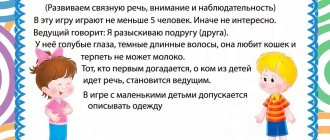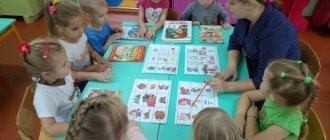Do-it-yourself tutorials for forming an air jet for kindergarten
Methodological development with manuals on the formation of an air jet “Working on an air jet is the key to quickly producing sound”
Author: Tatyana Aleksandrovna Savosina, speech therapist Place of work: MDOU “Kindergarten No. 14 “Hedgehog”, Saratov Description of the material: methodological development with 3 manuals on the topic “Working on an air stream is the key to quickly producing sound.” The manuals will be useful for speech therapists in their work when forming an air stream. The methodological development describes the role of the air stream in the production and assimilation of sounds, the main directions of the air stream, and provides methodological recommendations for corrective work on the air stream; The following is a description of 3 manuals on the formation and development of an air stream with photographs of the manuals. The manuals can be used when working with any age group, but they are more applicable when working with preschool children of the senior and preparatory groups. Goal: building work on the air stream, which affects the effective and rapid acquisition of pure sound pronunciation, achieving results in the field of speech correction. Objectives: 1. To attract the attention of teachers and parents to the problem of speech disorders in children. 2. Develop the strength, directionality, and smoothness of the air stream for quick and effective production of sounds. 3. Induce a positive and joyful emotional mood in class with the help of manuals, stimulate desire and interest in further correctional work. Timely acquisition of literate speech and clear sound pronunciation is of no small importance for the formation of a child’s full and harmonious development. Good speech is one of the main indicators of a child’s readiness to successfully master material at school. Deficiencies in sound pronunciation and other speech disorders can contribute to problematic learning and lead to a young student’s lack of self-confidence, which in turn will signal far-reaching negative consequences. Therefore, it is worth taking care of the child’s speech development in advance, the sooner the better. At present, unfortunately, the number of such children with speech defects, and especially with impaired sound pronunciation, is not only not decreasing, but, on the contrary, increasing. Speech is not our innate ability; it is formed in stages, and the process of its development depends on many reasons. We pronounce all the sounds of our speech, as you know, while exhaling. Accordingly, if the speech exhalation is incorrect, all sounds will sound blurry and unclear. Conversely, mastered correct exhalation - in the middle of the tongue - can normalize the quality of all speech sounds in children, as well as significantly reduce the time spent working on each sound. The production of a strong directed air stream is a necessary condition for sound production. You can work on the development of air flow and speech exhalation in a variety of ways: inflating balloons and soap bubbles, blowing a whistle, harmonica, pipe, blowing out candles. Such toys develop both the strength and duration of the air stream. The direction of exhalation is more difficult to adjust. Here, exercises such as blowing on a protruding tongue are used, where you need to ensure that the air stream goes down the middle of the tongue. The main directions for the air stream are identified: 1) the air stream passes straight through the center of the tongue. This direction corresponds to the pronunciation of most sounds: labiolabial (V, V', F, F', posterior lingual (K, K'. G, G'. X, X'), anterior lingual (T, T', D, D' ), whistling (S, S', Z, Z', C). 2) the stream passes upward through the center of the tongue. This direction is typical for the pronunciation of hissing sounds (Ш, Ж, ШЧ, Ш) and vibrants (Р, Р'). 3) the jet passes along the lateral edges of the tongue. This direction is typical for the pronunciation of stop-passive (L, L') sounds. Formation of an air stream for different groups of sounds: • Wide stream (for pronouncing hissing sounds); narrow jet (for making whistling sounds) • Warm jet (for making hissing sounds); cold stream (for making whistling sounds) • Scattered or directed air stream • Weak or strong air stream In the process of creating the correct air stream, you should adhere to these methodological recommendations: • Carry out exercises in a ventilated room. • The best results are achieved if the exercises are performed in a free body position, not sitting, but standing: the posture is straight, the chest is straightened. • Inhale deeply and calmly through the nose. Exhale through the mouth: light, smooth, long. • Monitor the direction of the air stream. • Exercises do not last longer than 3 minutes. • The amount and pace of exercises should be dosed correctly: blow intensely no more than 5 times. • Make sure that your cheeks do not puff out during exercise. • Exhaled air must not be retained. • Exercises are easier to do by counting. • For visual control at the initial stages, the use of a mirror is allowed. • The exhaled air stream is controlled using a cotton swab brought to the child’s mouth: if done correctly, the cotton swab will deflect. Work on the development of an air stream begins at the preparatory stage of the formation of correct sound pronunciation, along with the development of phonemic hearing and articulatory motor skills. I offer teaching aids that I have developed that will help produce a strong and smooth air stream. The manuals are colorful, attract attention and arouse children's interest in the activity. With such aids you can conduct a lesson in a playful way. 1. A cup of hot tea.
Aid for developing the duration and smoothness of the air stream, for developing a directed air stream.
Instructions: You need to cool the hot tea. To do this you need to blow steam. 2. Butterfly
Aid to produce a strong, long-lasting smooth air stream.
Instructions: Blow hard on the butterfly and it will fly away from the flower. 3. Hedgehog collects mushrooms
Aid to produce a strong, long-lasting smooth air stream. Instructions: Let's help the hedgehog collect mushrooms. But first you need to find them under the leaves. Blow on the leaves and help the hedgehog find all the mushrooms. We work on the formation of an air stream from the very first lessons, and the correction of sound pronunciation will be quick and timely.
We recommend watching:
Do-it-yourself cut-out pictures for preschoolers Methodological development of a thematic walk for children of senior preschool age Educational games in fine arts lessons Ways to implement the Federal State Educational Standard in fine arts lessons
Similar articles:
To the authors
DIY educational panel for kindergarten
Games to develop speech breathing
Games to develop speech breathing
Games to develop speech breathing
Games to develop speech breathing
Recently, there have been many children suffering from speech disorders. They have a weakness in the force of exhalation and the duration of speech exhalation
.
Therefore, the development of breathing
is one of the first and very important stages of corrective action on children with speech disorders.
Speech breathing
- is the main source of energy in the formation of speech sounds.
Speech breathing
differs from physiological breathing in that it is arbitrary, inhalation is shorter, exhalation, on the contrary, is slow, intermittent, and subordinate to the pronunciation of the text.
The formation of speech breathing involves
, including the production of an air stream. The production of an air stream is considered one of the necessary and significant conditions for producing sounds: sounds are pronounced in the exhalation phase.
Respiratory
exercises are needed to strengthen the air stream,
develop
the focus of the air stream (blow with the lips or on the tongue,
develop
the duration of the air stream.
Breathing
exercises increase ventilation of the lungs, so
games
should be played in a clean, ventilated room. Make sure that the child does not become dizzy. As soon as the head dizzy, take a break, gradually day by day, increasing the duration.
Games to develop speech breathing
can be divided into three groups:
1. Development games
air jet force.
2. Development games
duration of the air stream.
3. Development games
purposefulness of the air stream.
Development games
air force
"Seasons"
.
Goal: development
strong smooth oral exhalation; activation of the labial muscles.
Equipment: boxes decorated according to the seasons: winter - snow - polystyrene foam, spring - a tree with birds, summer - butterflies, autumn - autumn leaves made of paper; straws.
"Sultans"
Goal: development
strong smooth oral exhalation; activation of the labial muscles.
Equipment: attach strips cut from colored bags or garbage bags and fastened together to a wooden skewer.
"Snails"
Goal: development
strong smooth oral exhalation; activation of the labial muscles.
Equipment: snails and fields printed and laminated
Development games
air blast duration
"Father Frost"
Goal: development of long-term
, smooth exhalation, activation of the lip muscles.
Equipment: candy boxes, confetti inside; A hole was drilled in Santa Claus's hat for a straw.
"Insects"
Goal: development of long-term
, smooth exhalation, activation of the lip muscles.
Equipment: printed and taped insects attached to pencils.
It is known that the respiratory organs, along with the main biological function of gas exchange, also perform voice-forming and articulatory functions. The development of speech breathing in a child in ontogenesis occurs simultaneously with the development of speech and is completed by approximately 10 years. “Speech breathing is a system of voluntary psychomotor reactions closely related to the production of oral speech”The formation of speech breathing involves, among other things, the production of an air stream. The production of an air stream is considered one of the necessary and significant conditions for producing sounds. Work on the education of an air stream begins at the preparatory stage of the formation of correct sound pronunciation, along with the development of phonemic hearing and articulatory motor skills.
An important section of speech therapy work is the development of breathing and the correction of its disorders. It is very important to teach a child proper breathing, since breathing is the energetic basis of our speech. With proper speech breathing, the child will be able to pronounce sounds correctly, speak loudly, clearly, expressively, smoothly and observe the necessary pauses. Some consonants require a vigorous, strong exhalation. Children should be offered exercises that they perceive as games.
Breathing exercises help to align the processes of excitation and inhibition in the cerebral cortex, assimilate reflex connections, and have a positive effect on the functions of the neuroregulatory mechanisms that control breathing. The game manual consists of game exercises for the development of an air stream, the goals and objectives of which are:
- Formation of a targeted air stream.
- Development of air jet force.
- Development of breathing through the production of an air stream and mastery of the articulation of certain sounds.
- Activation of the labial muscles.
In the process of corrective work on the formation of an air stream, it is important to adhere to the following methodological recommendations:
- exercises are carried out in a well-ventilated area;
- pay attention to the fact that the child inhales deeply and calmly through the nose. Exhalation through the mouth should be light, smooth, long, economical, without tension;
- monitor the accuracy of the direction of the air stream;
- short duration of exercises from 30 seconds to 1.5 minutes;
- dosage of quantity and pace of exercises;
- Do not trap the blown air. You can hold your cheeks with your hands to use tactile control;
- You can’t puff out your cheeks.
The set of the game manual includes exercises for the development of air flow:
- "Vane"
- "Melody of the Wind"
- "Fast Boats"
- "The Power of the Wind"
- "Wind was blowing from sea"
- "Weather Center"
Exercise “Weather vane” Equipment:
pinwheel toy tower
Instructions for carrying out:
“Smile.
Show your teeth. Open your mouth slightly. Pull out your lips with a tube. Blow on the weather vane" Exercise "Melody of the Wind" Equipment:
bubble
Instructions:
for the bubble to hum, the lower lip should lightly touch the edge of the neck of the bubble.
The blown stream can be long or abrupt, and the background pattern will change accordingly. Exercise “Fast boats” Equipment
: containers with water, improvised boats
Instructions for carrying out:
“Smile.
Show your teeth. Open your mouth slightly. Pull out your lips with a tube. Blow on the boat. In order for the boat to move smoothly, you need to blow on it slowly. To swim quickly, we blow out the air with force. Don’t puff out your cheeks.” Exercise “The Power of the Wind” Equipment:
children’s plastic whistles
Instructions:
exhale through the mouth, the exhalation should be strong and fall exactly into the bell of the whistle, and for this you need to hold it tightly with your lips, the air should not come out through the nose.
Exercise “The wind was blowing from the sea” Equipment:
a glass of water, a straw for a cocktail
Instructions:
“Smile.
Show your teeth. Open your mouth slightly. Grasp the straw with your lips. Blow through the straw to make the water in the glass bubble.” The straw is placed in the middle of the tongue. The exhalation force is adjustable - weak and strong air stream. Exercise “Weather Center” Equipment:
clouds cut out of cardboard and double-sided colored paper with raindrops
Instructions:
“Smile. Show your teeth. Open your mouth slightly. Place your wide tongue on your lower lip. Lift the sides of your tongue. Create a groove. Blow on the droplets.” Try to keep the droplet in the “falling” position on the exhaled air stream for as long as possible.










